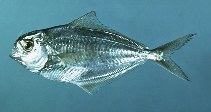
NOAA describes it unflatteringly as a "small, bony foodfish." Butterfish live along the Atlantic coast of North America from Florida to Newfoundland, and they've been fished commercially for some time, with predictable results:

These days, not many people make a living off butterfish. As you can see from the incredibly low landings (which have not increased since 2005), it just doesn't make economic sense. But butterfish are still being caught and killed, as a side effect of a different fishery--the Atlantic longfin squid.
These are longfin squid:

People started fishing them commercially a little while after they starting fishing butterfish. Here are the landing data:

It's pretty obvious that they're doing better than the poor butterfish--although there is a notable decline in 2006-2007, which has continued through 2009.
Both FishWatch and Seafood Watch have given the longfin squid fishery a big thumbs-up for responsible management. They think the fishery is sustainable, and we'll be able to keeping catching and eating longfin squid indefinitely. Yay!
But there's a problem: the nets that fishermen use to catch longfin squid also ensnare butterfish. And butterfish populations are very low. In fact, in 2004 a stock assessment workshop determined that butterfish were officially overfished (read that phrase aloud--it's fun!).
So in 2005 a limit was placed on how many butterfish the squid fishermen are allowed to catch. If they hit the butterfish limit, they have to stop fishing, even if there are still plenty of squid left in the ocean. In 2005, the limit was 4,545 metric tons, and in 2008 it was further reduced to 1,500 because the butterfish still weren't doing well. (If you look at the graph of commercial landings above, you'll see that 1,500 tons is about what the catch was in 2005.) The limit has stayed at 1,500 ever since.
Until Monday, when NOAA made an emergency decision to increase the butterfish limit to 1,811 metric tons.
It wasn't an "emergency" the way we usually think of it, for example, a terrible earthquake and tsunami. Rather, NOAA has the ability to make emergency rules on the basis of three criteria:
(1) The emergency results from recent, unforeseen events or recently discovered circumstances; (2) the emergency presents serious conservation or management problems in the fishery; and (3) the emergency can be addressed through emergency regulations for which the immediate benefits outweigh the value of advance notice, public comment, and deliberative consideration of the impacts on participants to the same extent as would be expected under the normal rulemaking process. NMFS policy guidelines further provide that emergency action is justified for certain situations where emergency action would prevent significant direct economic loss, or to preserve a significant economic opportunity that otherwise might be foregone.In the case of the butterfish/longfin squid situation, there are "recently discovered circumstances" (1) in the form of new survey data. The NOAA folks figured there would be "management problems" (2) in the longfin squid fishery if they didn't incorporate these new data immediately. And, they say,
The benefit of increasing the butterfish ABC and applying the increase to the butterfish mortality cap through this emergency action will be immediate to the Loligo fleet, and therefore outweighs the value of going through the normal rulemaking process.In case it's not immediately obvious what the "benefit" (3) is, they spell it out:
This action provides the benefit of allowing the Loligo fleet to optimize its harvest, with less concern that the fishery could be closed due to the butterfish mortality cap."Optimize harvest" means, of course, to catch more squid and make more money. Yay!
Here's the official description of the situation, from which all the above quotes are taken. I love that it's freely available online.




Comments